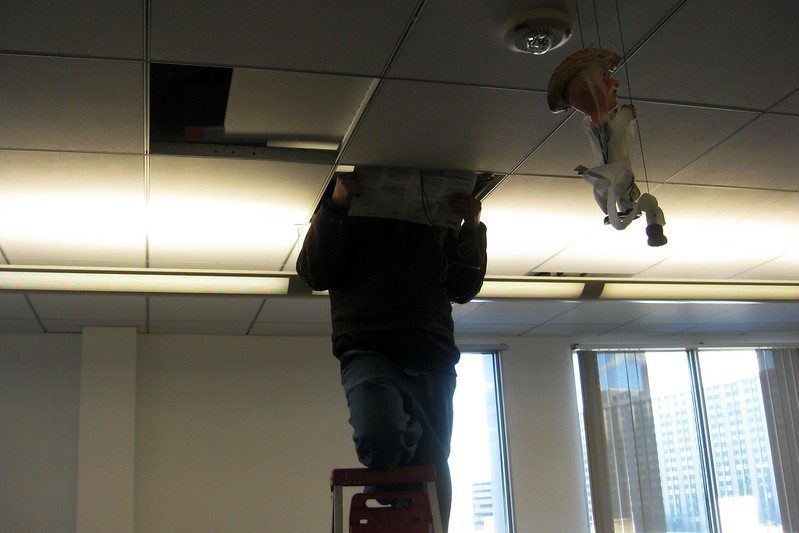Causes AC Vent Drip Water
Water dripping from an AC vent can be troubling for homeowners, signaling potential issues within the air conditioning system. This phenomenon is often caused by condensation on the unit’s evaporator coils. When the coils become excessively cold, moisture from the air condenses on them and drips into the ducts, eventually emerging from the vents.
Another common cause is a clogged condensate drain line, which prevents water from properly draining away from the unit. To address these issues, it is advisable to check and clean the air filters regularly to ensure proper airflow and to inspect the condensate drain line for any blockages.
Additionally, scheduling regular maintenance with a professional HVAC technician can help prevent these problems and ensure efficient air conditioning system operation.
Finding the cause of an air leak and fixing it quickly is critical to reducing damage to the home. Fortunately, most of these problems are fairly easy to fix.
Most leaks from the AC system vents are intermittent problems that could appear every two years or so. Proper preventative maintenance of air vents in the HVAC system, especially annual cleaning and regular air filter changing, will go a long way towards eliminating these problems.
When warm water air starts leaking from an empty AC unit vent, the immediate thought is that there is something wrong with the air conditioning unit. That is a definite possibility, but it is probably not true.
There is no water run to the HVAC air handling unit in the house, so any air leaks come from a secondary source, one sort or another, even if that source is associated with the HVAC air handling unit.

Fixing the AC
Installation Issues
Improper installation of the AC unit or drip pan can cause condensation to pool and Water to drip from the AC Vent.
Improper AC unit installation or drip pan installation can lead to condensation issues. When an AC unit is not installed correctly, or the drip pan is not positioned or functioning properly, several problems can arise:
- Pooling Condensation: Condensation may accumulate in the drip pan or around the unit instead of draining properly.
- Dripping: If the drip pan is not positioned correctly or is damaged, condensation can drip onto floors, walls, or other surfaces, potentially causing water damage.
- Mold and Mildew: Excess moisture from improper drainage can create a breeding ground for mold and mildew, leading to health issues and damage to the structure.
- Reduced Efficiency: Improper installation can affect the overall efficiency of the AC unit. Condensation pooling can indicate that the unit is not removing humidity from the air as effectively as it should, resulting in a less comfortable indoor environment.
Ensuring that a qualified professional installs your AC unit according to manufacturer specifications is crucial to avoid these issues. Regular maintenance checks should also include inspecting the drip pan and drainage system to ensure they are clear and functioning correctly.
Air Filter Issues
A dirty air filter can cause your air conditioner to freeze, leading to water dripping from the vents. Here’s how it happens:
- Restricted Airflow: A dirty air filter impedes air flow through the air conditioning system. When there isn’t enough airflow over the evaporator coil (the part that cools the air), the coil can become too cold.
- Condensation Build-Up: The evaporator coil absorbs heat from the air passing over it. As this happens, moisture in the air condenses on the coil and drips down into the condensate pan below.
- Freezing of Condensate: The evaporator coil can get excessively cold if the airflow is restricted due to a dirty filter. When the temperature drops below freezing, the condensate that drips down onto the coil can freeze into ice.
- Ice Build-Up: As ice forms on the evaporator coil, it further restricts airflow and insulates it, preventing it from effectively absorbing heat. This creates a cycle where more ice forms, worsening the problem.
- Water Leakage: As the ice melts or the system cycles off and thaws, the excess accumulated water may drip from the vents inside your home.
To prevent this issue:
- Regularly Change Air Filters: Check and replace air filters as recommended by the manufacturer (typically every 1-3 months, depending on usage and type of filter).
- Keep Vents Clear: To maintain good airflow, ensure that vents and registers are not blocked by furniture or other objects.
- Annual Maintenance: Schedule annual maintenance with a qualified HVAC technician to clean coils, check refrigerant levels, and ensure the system functions properly.
Addressing a dirty air filter promptly not only helps prevent freezing and water leakage but also ensures your air conditioner operates efficiently, saving energy and potentially extending the lifespan of the equipment. Changing the air filter can resolve the issue.
Condensate Drain Line Issues
A clogged AC drain line can cause water to accumulate within an air vent. Here’s how this happens:
- Condensate Drain Line: During normal operation, your air conditioner removes moisture from the air through the evaporator coil. This moisture collects as condensate and is directed out of your home through a drain line.
- Clogging of Drain Line: Over time, the condensate drain line can become clogged with dirt, algae, mold, or other debris. When this happens, the condensate cannot properly drain outside and may return to the system.
- Water Accumulation: If the drain line is completely clogged or partially obstructed, condensate water has nowhere to go and can accumulate within the air handling unit or even back up into the ductwork.
- Leaks and Water Damage: As water accumulates, it can eventually leak out of the air vents or even cause damage to ceilings, walls, or floors if it overflows from the air handling unit.
To prevent this issue:
- Regular Maintenance: Schedule regular maintenance for your HVAC system, including inspecting and cleaning the condensate drain line.
- Check for Signs: Look for signs of a clogged drain line, such as water around the air handler, moldy odors, or water stains on ceilings or walls.
- Clear Obstructions: If you suspect a clog, try clearing the drain line using a wet/dry vacuum or flushing it with bleach and water (consult manufacturer instructions or a professional for guidance).
- Install a Drain Line Cleanout: Some HVAC systems have cleanout access installed on the condensate drain line, making it easier to clean and maintain.
By maintaining a clear and functioning condensate drain line, you can avoid the potential issues of water accumulation within air vents and ensure your HVAC system operates efficiently and effectively. Unclogging the drain line with distilled vinegar or a shop vac can resolve the issue.
Air Leak and Insulation Issues
Insufficient insulation in air ducts can lead to condensation buildup and dripping from the vents. Here’s how this happens:
- Temperature Difference: Air ducts carry cooled or heated air throughout your home. If the ducts pass through areas with significantly different temperatures (such as attics or crawl spaces), and if the ducts are not properly insulated, the temperature difference between the duct surface and the surrounding air can cause condensation to form on the outer surface of the ducts.
- Humidity: Humidity levels in these spaces can exacerbate condensation. When warm, humid air comes into contact with the cooler surface of uninsulated ducts, moisture in the air can condense on the ducts’ exterior.
- Drip Formation: As condensation accumulates on the exterior of uninsulated ducts, it can eventually reach a point where it drips off the ducts and into the living spaces through the vents.
- Water Damage and Mold: Dripping condensation can lead to water stains, damage to ceilings or floors, and potentially create conditions conducive to mold growth if not addressed promptly.
To prevent condensation issues due to insufficient insulation in air ducts:
- Inspect Ductwork: Regularly inspect the condition of your ductwork, especially in areas with significant temperature differences.
- Add Insulation: Ensure that ducts passing through unconditioned spaces (like attics, crawl spaces, or basements) are properly insulated with insulation appropriate for your climate.
- Seal Ducts: In addition to insulation, ensure that ducts are properly sealed to prevent air leaks, which can also contribute to temperature differentials and condensation issues.
- Manage Humidity: Use dehumidifiers or HVAC systems with humidity control features to manage indoor humidity levels, which can help reduce the potential for condensation on duct surfaces.
By addressing insulation and ensuring proper HVAC system maintenance, you can mitigate the risk of condensation buildup and Water Dripping from AC Vent, improving comfort and preventing potential water damage.
Fixes for AC Vent Dripping Water Conclusion
Regular Maintenance
- Regularly inspecting and maintaining your AC system can help prevent air leaks and other issues.
- Changing the air filter and allowing the unit to return to its normal function can resolve the issue.
Repair and Replacement
- Clearing a clogged condensate drain line is a DIY-friendly task, but if you’re unsure, consult an HVAC professional.
- Replacing a rusty drip pan can help avoid water spillage from your air conditioning unit.
Professional Assistance
- If you suspect a refrigerant leak, it’s best to call a licensed HVAC professional to identify and repair it.
- If you’re experiencing water leaking from your air vent, schedule an appointment with an HVAC professional to resolve the issue.



